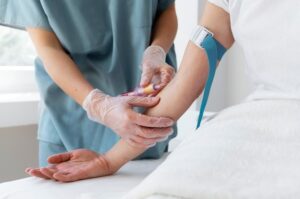Five Factors to Consider While Choosing PRP Hair Treatment

There are plenty of treatments available for thinning hair. PRP hair treatment is one of the most revolutionary ones to tackle the problem of hair loss. But what exactly is PRP hair treatment?
About PRP Hair Treatment
PRP stands for platelet-rich plasma. Plasma is one of the components of blood. The plasma is obtained from the patient’s blood, which is drawn before the treatment begins. The blood is then purified and separated into different components using a device known as the centrifuge. One of the components obtained through this process is PRP.
Platelets contain certain growth factors that can help with many problems including hair loss. Growth factors essentially enhance cell functions, thus, helping treat problems related to skin, hair, and in several cases even muscles and bones.
When PRP is used for hair loss treatment, it can boost the functions of hair follicles. When hair follicles function well, new hair growth becomes a possibility.
Here are five factors to consider when choosing PRP hair treatment.
It is best to begin PRP hair treatment as soon as you begin to experience hair loss
People who are just beginning to experience hair loss can benefit greatly from PRP treatment. Growth factors can stop hair loss before it becomes severe. PRP treatment can accelerate hair growth on your scalp before bald spots begin to show. PRP is also extremely beneficial for those people who have androgenic alopecia. It is a genetic condition that causes thinning of hair.
Even though PRP treatment is useful for all types of hair loss problems, it might be more useful for the above-mentioned cases of hair loss.
It is vital to choose qualified providers for PRP treatments
PRP is not your usual cosmetic or spa treatment. It is a medial process requiring careful handling by the provider. For example, if you are seeking PRP hair treatment in NYC then choose only those clinics that are run by qualified doctors or nurses. Also, consider the experience of your providers in offering PRP treatments.
PRP needed to be obtained properly and injected carefully into the scalp. Improper handling can cause bruising, and the treatment may not even work. Qualified medical professionals can also recommend other complementary treatments such as vitamin infusions to aid your hair growth along with PRP.
Consistency is important for successful outcomes from PRP hair treatments
PRP is extremely beneficial for hair loss problems. But one treatment session won’t be sufficient to rectify hair loss. You can expect the shedding of your hair to reduce drastically after your first treatment session. But you will need multiple sessions for the right results. After 3-4 sessions, you can expect new hair growth on your scalp. Your provider will determine the ideal treatment course for you depending on your unique needs.
It is vital to discuss your medical history with your provider openly.
PRP treatments are not ideal for those suffering from blood-related disorders. Some people have medical conditions that affect clotting of their blood. PRP may not be the right treatment for them. So, it is important that you reveal this information to your provider before seeking PRP hair treatment. If your provider is a qualified doctor or a nurse, then they can offer you other alternative treatments to treat your hair loss problem if PRP might not be the right one for you.
It is best to disclose all medicine use to your provider. If you are pregnant or nursing, it is important that you tell your provider about it.
The cost of PRP treatments can vary
The cost of PRP hair treatments can vary from one clinic to the next depending on the location and the experience of the providers. It is best to first schedule a consultation with a provider to assess the cost factor before outright scheduling a treatment session if cost is an issue with you.
PRP is a safe, nonsurgical solution for hair loss problems. It carries none of the risks of hair transplant surgeries or long-term use of medicines for hair growth. The treatment utilizes the patient’s own blood to stimulate cells responsible for hair growth.

